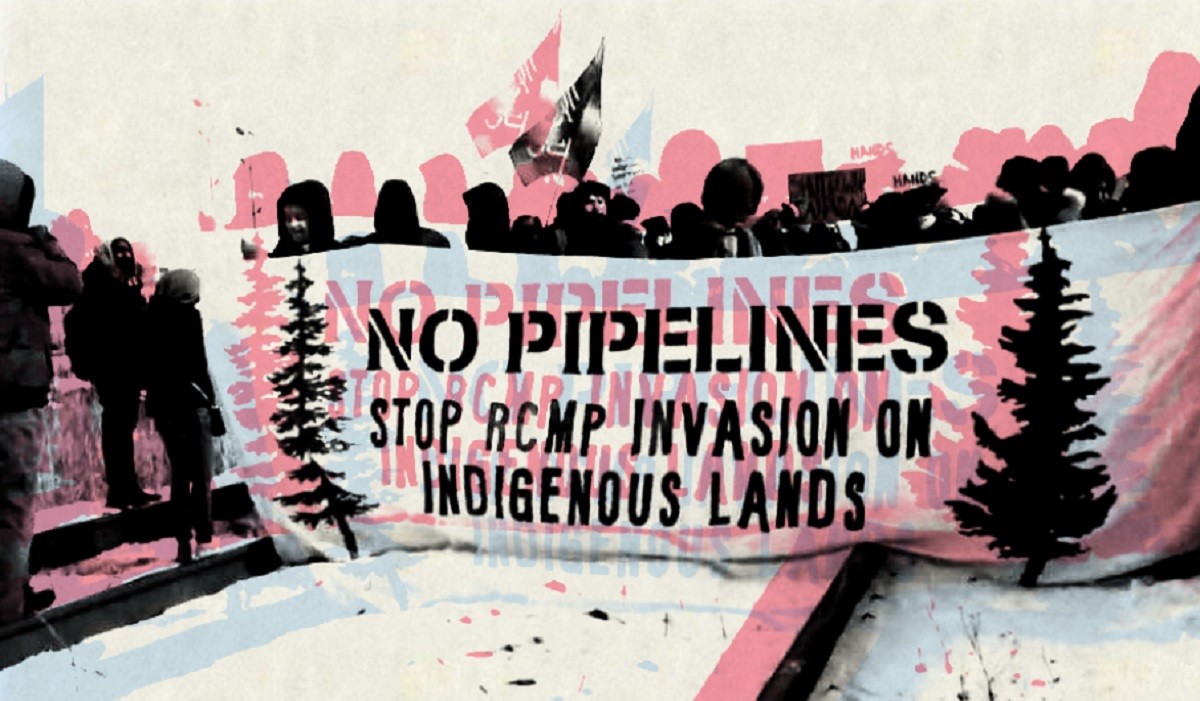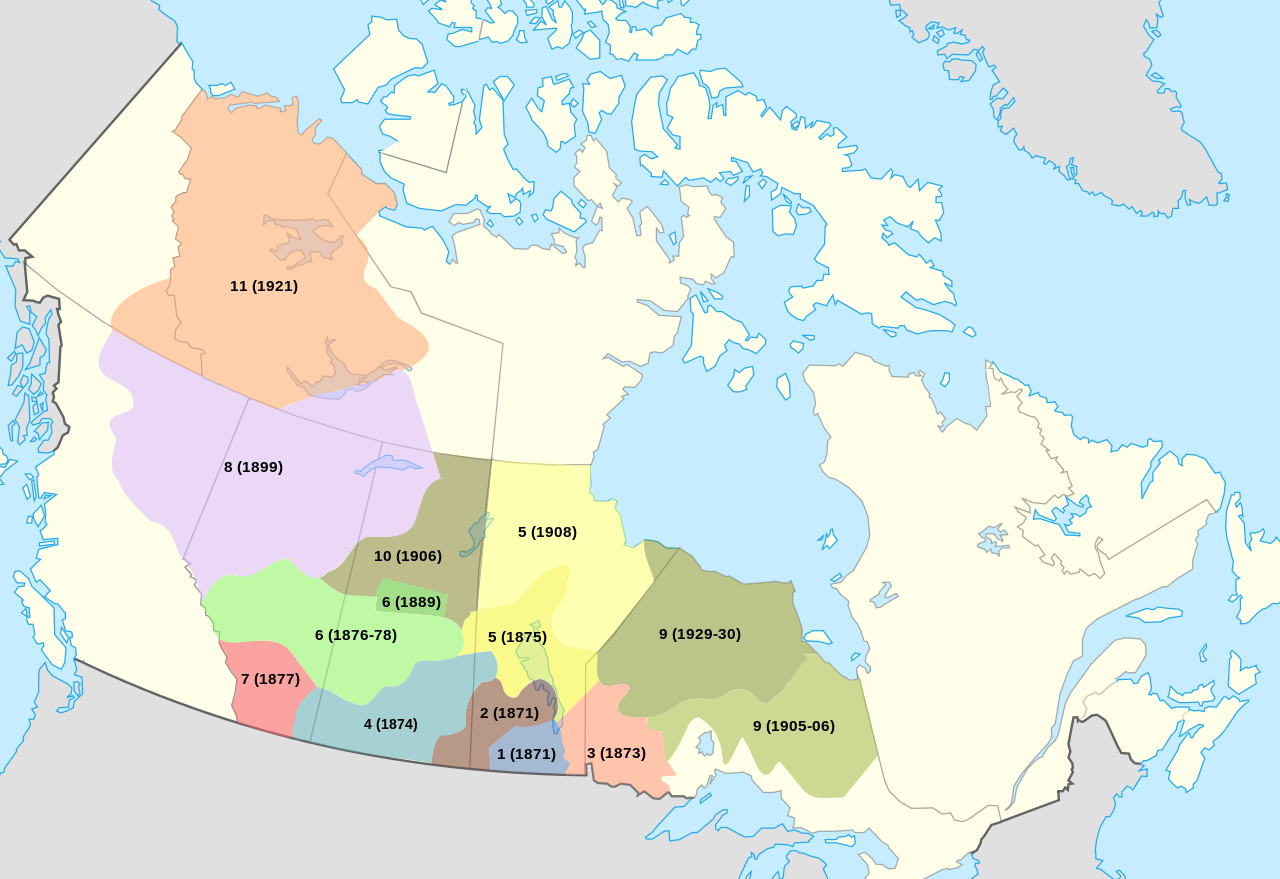Filed under: Analysis, Canada, Capitalism, Development, Indigenous, The State

This article is an extended version of “From Sea to Sea”: Train Blockades, Colonialism and the Canadian Railways History, published on February 15th on Contrepoints.Media, a new site chronicling autonomous anti-capitalist and anti-colonial struggles.
Canadian National Railway network has been paralyzed for more than a week by blockades in solidarity with the Wet’suwet’en community, who opposes the construction of the Coastal GasLink pipeline on their unceded territory. The Mohawk community of Tyendinaga has been blocking passenger and freight train traffic between Toronto and Montreal since February 5th, and a railway blockade in New Hazelton, B.C. has forced the closure of the Port of Prince Rupert. Blockades in solidarity with the Wet’suwet’en have since multiplied across so-called Canada as camps have been set up on the tracks at Kahnawà:ke, Listuguj, Halifax/K’jipuktuk, Diamond, among others.
In response to the Wet’suwet’en call for solidarity following last week’s raid by the Royal Canadian Mounted Police (RCMP) of Camp Unist’ot’en, numerous blockades of critical transportation infrastructure have paralyzed both freight and commuter lines throughout so-called Canada. On Thursday, the Canadian National Railway announced the indefinite closure of its Eastern Canadian Network, and the entire Via Rail passenger network.
Economic elites are sounding the alarm: propane shortages, profits lost, restricted travel for workers, and thousands of temporary layoffs encourage the public to maintain the status-quo—the reputation of Canada as a leading exporter of grain is at stake. While the president of the Canadian Chamber of Commerce resounds that a rail gridlock of this magnitude represents an emergency for the Canadian economy, Prime Minister Justin Trudeau calls on protesters to “respect Canadian law enforcement,” and Conservative Leader Andrew Scheer insists those in solidarity with Wetsu’wet’en peoples should “check their privilege,” court injunctions for unprecedented repression pile up.
The Wet’suwet’en and Coastal GasLink
In recent years, oil and gas companies including TC Energy (formerly TransCanada), Enbridge, and Pacific Trails, have attempted to build pipelines without the consent of Hereditary Chiefs, inside the Wet’suwet’en Traditional Territory situated just over 400 miles north of the city of Vancouver, British Columbia. The hereditary chiefs remain opposed to agreements made by Band Councils, imposed political institutions created by the Canadian government to legislate colonial negotiations, which enforce the rights of these corporations to extract resources with impunity. It is on Unist’ot’en land—a territory that has never been ceded—along the proposed Coastal GasLink Pipeline route, that camps, access points, and community resource centers have been erected to actively resist pipeline construction, defending Wet’suwet’en territory, traditions and the future generations that will inhabit these lands.
The Coastal GasLink Pipeline, the most expensive project of its kind to date with nearly $6 billion invested, is the focal struggle for Wet’suwet’en protectors and their allies. The occupation and defense of this territory by Camp Unist’ot’en seeks to affirm Wet’suwet’en’s sovereignty by refusing to negotiate with TC Energy representatives and restricting their entry to the territory.
In early January 2019, a court sanctioned injunction was issued to allow Coastal GasLink Pipeline LTD. access to the site in order to complete the construction of the CGL pipeline. In response, the Gidimt’en Yintah clan established defensive access control to their territory at kilometer 44.5 of the Morice River Forest Road, a river system several municipalities rely on. Heavily armed RCMP raided Gidimt’en Yintah ancestral lands later that month, dismantling the gates and arresting 14 protectors. An article in the Guardian from December 2019 revealed RCMP tactical notes approving the use of lethal force against Indigenous land defenders.
In the week following the RCMP invasion of Wet'suwet'en territories supporters have risen up and #ShutDownCanada. Some of the most effective solidarity actions have come in the form of rail blockades that have paralyzed the national economy.#WetsuwetenStrong #RCMPOut #LandBack pic.twitter.com/p6PgM50st8
— submedia (@submedia) February 15, 2020
On December 31, 2019, TC Energy obtained a new injunction; this time from the Supreme Court of British Columbia, citing that persons on Wet’suwet’en territory must remain 30 feet away from any representative or vehicle affiliated with the Coastal GasLink Pipeline. On February 6, the RCMP freely established an ‘exclusion zone,’ restricting access to reporters, residents, lawyers and allies within Wet’suwet’en territory.
Between February 6th and 10th, the RCMP invaded. Charging up the logging road with an arsenal of vehicles, deploying helicopters and a canine unit, a sound cannon and heavy machinery; they bulldozed barricaded entry points, ignoring the territorial ban from the Gidimt’en, and arrested more than 20 defenders, including many tribal elders. In response to this invasion of their traditional territory, the Wet’suwet’en have called upon their allies across Turtle Island to support their fight against the Canadian government, its colonial extractivism, its genocidal disregard for Indigenous sovereignty and tradition, and the oil and gas companies who view profits over peoples and lands.
The economic and political impact of these blockades affront the central role of extractivism and rail infrastructure in the Canadian economy, but they also highlight the deep, structural relationship between freight transportation and Canadian colonialism. Strikingly topical, the history of the development of the railway network illustrates how industrialization, the unification of the Canadian nation, Canadian law, colonialism and state violence are intertwined.
Railways at the Heart of the Canadian Constitution
During the second half of the 19th century, railway projects linking various points in the North American colonies multiplied. Entrepreneurs and businessmen invested colossal sums of money to establish new rail lines, supported by equally large government subsidies. Connected cities became strategic economic arteries, and railways contributed greatly to their industrialization, fueling new markets for wood, fuel oil, iron and steel. Railways made it possible to reach areas formerly inaccessible; and by providing transportation for settlers, goods, or armed forces, they quickly became the foundation for hinterland settlements.
A total of nearly 400 people have now blocked BOTH the 1st and 2nd largest rail yards in Canada, blocking US-bound CN trains. We will #shutdowncanada until the Wet’suwet’en demands for RCMP withdrawal and #noaccesswithoutconsent are respected. #WetsuwenStrong pic.twitter.com/UI32Kj1jnY
— Simran Dhunna (@dhunnasim) February 15, 2020
Much more than a mere economic tool, the railway system was at the heart of Canadian Confederation and played a key role in Canadian nationalism. The construction of the Intercolonial Railway, linking United Canada to the Maritime provinces, was made a condition of the signing of the Constitution Act of 1867. British Columbia then joined Confederation in 1871, following Prime Minister John A. McDonald’s promise to build the Canadian Pacific Railway (CPR) that would link eastern and western provinces. The Canadian Pacific Railway project became a major actor in the unification of Canada, both symbolically and materially. The government opted for a route that avoided crossing the American border and the territories belonging to the Hudson Bay Company, which until then had been mostly inhabited by First Nations and Métis communities. Widely subsidized, the construction of the CPR was marred by corruption scandals that ousted McDonald’s government in 1873.
Parallel to the CPR, a multitude of railways with less ambitious routes were built, once again subsidized by the government and raiding First Nations territories. Few of these speculation projects were actually profitable and many were on the verge of bankruptcy following the First World War. Several lines were bought and subsequently nationalized by the government, and then merged to create the Canadian National Railway.
The Indian Act and the North-West-Mounted-Police
The passage of the Indian Act in 1876 provided the legal framework for treaties that would allow the Canadian government to privatize and appropriate Indigenous lands crossed by the railways. The Band Council system and the reserve system enshrined in the Indian Act imposed a political structure and a concept of land ownership that was at odds with First Nations traditions and cultures, and allowed the government to dictate the terms of expropriation negotiations in a “legal” manner.
In 1873, the predecessor of the Royal Canadian Mounted Police (RCMP) – the North-West-Mounted-Police – was created for the specific purpose of controlling the Indigenous populations of the Prairies. Beginning in 1881, the Mounties were assigned to protect the construction of the Canadian Pacific Railway and moved their base to Regina, newly founded in preparation for the construction of the railway. Rail transportation was a major asset for the Mounted Police, allowing them to quickly mobilize recruits to deal with Métis uprisings and enforce the Indian Act.
Following the intentional extermination of the buffalo herds by settlers between 1870 and 1880, the survival of several prairie First Nations depended on the food supplies provided by the Mounted Police. The threat of famine forced them to sign treaties surrendering their territories to the Crown and assigning them to reserves north of the railway lines. Between 1871 and 1921, the Canadian Crown signed 11 treaties with the First Nations that ceded virtually all of the land from “Ontario” to the Rocky Mountains.
Interactive map of blockades in support of Wet’suwet’en
The Continuation of Canadian Colonialism: From Railways to Pipelines
The similarities between the history of railway construction and the various pipeline projects are more than coincidental. Government subsidies, buyouts of failing projects, theft of First Nations land, legal actions and intervention by armed forces: what emerges from the history of railways in the second half of the 19th century is the current persistence of the structural colonialism on which Canada was built. The appropriation of First Nations lands is at the heart of the Canadian Constitution and Law. Beyond the rhetoric of reconciliation, colonialism continues at the same pace and is still maintained today through legislation and brut force. Canada was built on exctractivism and the circulation of goods. The train blockades of the past week highlight not only the colonialist foundations of Canadian territory, but also its weaknesses, its dependence on its transportation infrastructure and the efficiency with which it can be shut down.








